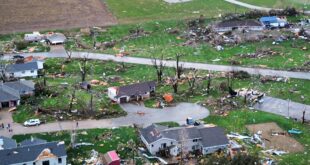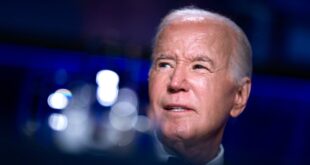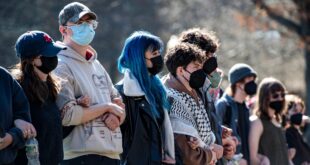[ad_1]
WASHINGTON — Democrats on the Senate Homeland Security Committee released a report Tuesday concluding that federal law enforcement agencies failed to correctly analyze a wide range of intelligence showing the potential for violence on Jan. 6, 2021.
The report, authored by the committee’s chair, Sen. Gary Peters, D-Mich., and staff, provides specific examples of threats of violence and plans for an attack on the Capitol, which were collected by agencies in the lead-up to Jan. 6, including the FBI and the Department of Homeland Security’s Office of Intelligence and Analysis (I&A). The report concludes that the agencies consistently downplayed the potential for violence and, as a result, the government did not prepare the proper security apparatus for Washington, D.C., that day.
”At a fundamental level, the agencies failed to fulfill their mission and connect the public and nonpublic information they received.” the report reads, pointing to internal emails and documents that “demonstrate the breadth and gravity of the threats these agencies received related to January 6th.”
As an example, on Jan. 2, 2021, four days before the Capitol riot, the social media platform Parler sent a post from a user on its site to the FBI that read, “[t]his is not a rally and it’s no longer a protest. This is a final stand where we are drawing the red line at Capitol Hill. […] don’t be surprised if we take the #capital [sic] building.”
That post was one of many alluding to the potential of violence leading up to Jan. 6. But the report found that despite violent online rhetoric, the FBI and the I&A continued to downplay the threat and instead advised the U.S. Capitol Police and Washington, D.C., Metropolitan Police force to prepare for a normal political rally.
“What was shocking is that this attack was essentially planned in plain sight in social media,” Peters said in an interview, “And yet it seemed as if our intelligence agencies completely dropped the ball.”
An internal email from the FBI’s Washington Field Office (WFO), cited in the report, outlined a collection of online threats, including a long list of videos, social media posts and message board activity detailing plans for an attack on Washington, but the email ultimately concluded that the threats were isolated and not evidence of a serious problem.
“FBI WFO does not have any information to suggest these events will involve anything other than [First Amendment] protected activity,” the email said, adding that the FBI had “identified no credible or verified threat to the activities associated with 6 January 2021.”
According to the report, similar streams of intelligence continued to flood federal agencies tasked with keeping watch for violent activity. But still on the morning of Jan. 6, as large crowds were already starting to gather on the National Mall, a Senior Watch Officer at the DHS National Operations Center wrote “[t]here is no indication of civil disobedience.”
In fact, the report concludes that intelligence analysts were more concerned — not about Trump’s supporters on the National Mall becoming a direct threat to members of Congress, but that violence could break out between the crowd and counter-protestors, including left-leaning groups like antifa. The report also contends that the FBI was focused on preventing attacks by lone-wolf extremists, while not doing enough to make sure law enforcement agencies were adequately prepared given the volume of threats online.
“The threats to the Capitol on January 6th were not made solely in private conversations that required secretive law enforcement investigative tactics to detect,” the report states. “On the contrary, these threats were made openly, often in publicly available social media posts, and FBI and I&A were aware of them.”
The FBI “is rightly constrained from taking investigative or enforcement action against an individual merely on the basis of First Amendment-protected speech,” the report continues. “However, FBI also has an obligation to take into account the larger threat picture, including social media and online calls for violence when there is a significant increase in threats that may indicate a growing danger of violence.”
In total, the report reveals that the FBI only issued two intelligence reports related to the potential for violence on Jan. 6. One originated from the New Orleans Field Office on Jan. 5, and another later that night from the Norfolk Field Office. Both reports were limited in scope and were not distributed widely by the FBI, according to the report, and neither FBI headquarters or Washington Field Office issued their own reports prior to the attack.
The intelligence reports that were issued dealt with threats of political extremism nationwide and did not address the specific threats to Washington or the Capitol itself.
Peters compared the obvious intelligence misses to the mistakes made in the lead-up to the 9/11 terrorist attacks.
“I think the failure was largely a failure of imagination, to see threats that the Capitol could be breached as credible, despite the fact that the threats were shared publicly and in such high volume in a variety of ways,” Peters said. “And I think the failure in a lot of ways echoes the findings of the 9/11 Commission, which identified similar failures to take warnings seriously.”
The Senate report comes as the Justice Department’s inspector general continues its own investigation into the FBI and DOJ failures ahead of the Capitol attack.
While Tuesday’s report goes into great detail about the lack of preparation by the various security and law enforcement agencies, it does not absolve former President Donald Trump for his role in fueling the violence that occurred on that day. It echoes the House Jan. 6 Committee’s conclusion that Trump was largely to blame for the events of that day, saying his false claims about the 2020 election results coupled with his tweet inviting supporters to Washington “directly contributed to this attack.”
“But,” the report’s conclusion reads, “the fact remains that the federal agencies tasked with preventing domestic terrorism and disseminating intelligence — namely FBI and I&A — did not sound the alarm, and much of the violence that followed on January 6th may have been prevented had they done so.”
Although the Jan. 6 committee had a team of staffers dedicated to investigating federal authorities’ failures to prepare for the Capitol attack, the panel’s executive summary and its final report avoided the type of direct critique of law enforcement that is laid out in Tuesday’s Senate Homeland Security Committee report. As NBC News first reported in November, staff on the Jan. 6 Committee probing law enforcement failures were told that the panel’s report would focus on Trump, which left much of their work on the cutting room floor. The committee did, however, release transcripts of the testimony they collected, much of which is cited in the Senate Homeland Security Committee report.
The report also outlines a long list of recommendations to prevent similar failures in the future. The committee calls for DHS and the FBI to complete full after-action reviews of their failures in the lead-up to Jan. 6 and to improve the process for analyzing and disseminating intelligence. The report also calls for Congress’ certification of future presidential elections to be declared National Security Special Events, which would mobilize law enforcement and provide special security enhancements.
 Latest Breaking News Online News Portal
Latest Breaking News Online News Portal





